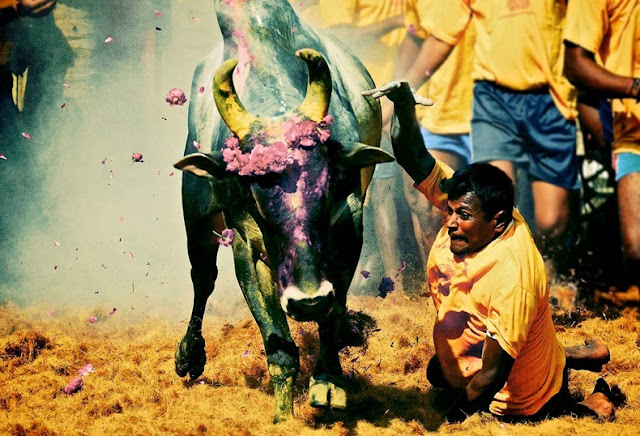பிரிவோம் சந்திப்போம் - "ஆனந்த விகடன்" வார இதழில் தொடர்கதையாக வெளிவந்த இந்த நாவலை சுமார் முப்பது வருடங்கள் நிறைந்த நிலையில் வாசித்திருக்கிறேன். இருந்தாலும் துளியளவும் சுவாரஷ்யம் குறையவில்லை.
சமீபத்தில், ஒரு 200 பக்க அளவு கொண்ட ஒரு புத்தகத்தை இத்தனை வேகத்தில் நான் வாசித்ததில்லை. முன்னரே படித்த கதைதான், தெரிந்த முடிவுதான். இருந்தாலும் சுஜாதாவின் எழுத்துநடை நம்மைக் கட்டிப் போடுகிறது.
நமக்கு ரொம்பவும் பழக்கமான ஒரு காதல் கதை. மேல்தட்டு வகுப்பைச் சேர்ந்த வளர்ந்த குழந்தையான கதைநாயகி மதுமிதா. பாபநாசத்தில் சீனியர் எஞ்சினியர் ஆபீசரான அவள் அப்பா. அவருடைய ஜூனியர் எஞ்சினியரின் மகனான எஞ்சினியர் கதைநாயகன் ரகுபதி. பெண் வீட்டு விருப்பத்துடன் / அனுமதியுடன் காதல், எப்போதும் எச்சரிக்கை பாவனையில் இருக்கும் ரகுவின் அப்பா, வேலை கிடைத்து சென்னை விஜயம், இடையில் வந்துசேரும் அமெரிக்க ராதாகிஷன், மதுவைப் பெற்றவர்கள் செய்யும் துரோகம், சண்டை, அழுகை, வீட்டில் பிடித்துவைத்த பிள்ளையாய் அமெரிக்க மாப்பிள்ளையை மணந்துகொண்டு மது அமெரிக்கா பறப்பதற்கு ஆயத்தமாவது என்று நிறைகிறது பிரிவோம் சந்திப்போம் - பகுதி 1.
நமக்குப் பழக்கமான சுஜாதாத்தனமான எலக்ட்ரிகல், எலக்ட்ரானிக்ஸ் தகவல்கள், வவேசு ஐயர், ஆம்ஃபிட்டமின் அல்லல்கள், ஆயிரம் வயலின்கள், காதல்ங்கறது Nature's way of ensuring pregnancy என்று மகனிடம் பேசும் அப்பா, …என்று எல்லாமுமே உண்டு. இவற்றையெல்லாம் தாண்டி சுஜாதாவின் சுவாரசிய நடை என்னும் விஷயம் அந்த 200 பக்கங்களையும் நம்மை எக்ஸ்ப்ரஸ் வேகத்தில் படிக்க வைத்துவிடுகிறது.
சுஜாதா ‘காட்சிப்படுத்துதலின்’ மாஸ்டர். பிரிவோம் சந்திப்போம் திரைப்படமாக "ஆனந்த தாண்டவம்" என்ற பெயரில் சமீபத்தில் வெளிவந்தது . திரைப்படத்தை நான் பார்க்கவில்லை என்றாலும் சொல்கிறேன். இந்த காலகட்டத்திற்கு ஏற்ப சில மாறுதல்கல் செய்யும் தேவை தவிர்த்து அந்தத் திரைப்பட இயக்குநருக்கு திரைக்கதை எழுதுவதற்கு தனியே வேலையே இருந்திருக்காது என்பது திண்ணம். அத்தனை கச்சிதமாக திரைக்கதை, வசனம், காட்சியமைப்பு என்று எல்லாமுமே ப்ரீலோடடாக இந்தக் கதையில் உண்டு.
அசாத்திய புனைவு ஆற்றல், பல்துறை ஞானம், அதைச் சரிவர தன் கதைகளில் இடைச்செருகி படிப்போரைச் சிலாகிக்க வைத்தல், தொய்வின்றி கதை சொல்லும் மந்திரவித்தை என்று சுஜாதாவிடம் சொல்ல இருநூற்று ஐம்பது ப்ளஸ்கள் உண்டு. இது பகுதி -1’தான். அமெரிக்காவிற்கு மேல்படிப்பிற்காக ரகு பயணப்படும் பகுதி -2 இன்னமும் சுவாரசியம் மிகுந்தது. நம்ம லைப்ரரியில் அந்தப் புத்தகத்தைக் காணலை. கிடைத்தவுடன் வாசித்துவிட்டு அந்தப் புத்தகத்தையும் பார்ப்போமே. சிறு இடைவெளிக்குப் பின்....
சமீபத்தில், ஒரு 200 பக்க அளவு கொண்ட ஒரு புத்தகத்தை இத்தனை வேகத்தில் நான் வாசித்ததில்லை. முன்னரே படித்த கதைதான், தெரிந்த முடிவுதான். இருந்தாலும் சுஜாதாவின் எழுத்துநடை நம்மைக் கட்டிப் போடுகிறது.
நமக்கு ரொம்பவும் பழக்கமான ஒரு காதல் கதை. மேல்தட்டு வகுப்பைச் சேர்ந்த வளர்ந்த குழந்தையான கதைநாயகி மதுமிதா. பாபநாசத்தில் சீனியர் எஞ்சினியர் ஆபீசரான அவள் அப்பா. அவருடைய ஜூனியர் எஞ்சினியரின் மகனான எஞ்சினியர் கதைநாயகன் ரகுபதி. பெண் வீட்டு விருப்பத்துடன் / அனுமதியுடன் காதல், எப்போதும் எச்சரிக்கை பாவனையில் இருக்கும் ரகுவின் அப்பா, வேலை கிடைத்து சென்னை விஜயம், இடையில் வந்துசேரும் அமெரிக்க ராதாகிஷன், மதுவைப் பெற்றவர்கள் செய்யும் துரோகம், சண்டை, அழுகை, வீட்டில் பிடித்துவைத்த பிள்ளையாய் அமெரிக்க மாப்பிள்ளையை மணந்துகொண்டு மது அமெரிக்கா பறப்பதற்கு ஆயத்தமாவது என்று நிறைகிறது பிரிவோம் சந்திப்போம் - பகுதி 1.
நமக்குப் பழக்கமான சுஜாதாத்தனமான எலக்ட்ரிகல், எலக்ட்ரானிக்ஸ் தகவல்கள், வவேசு ஐயர், ஆம்ஃபிட்டமின் அல்லல்கள், ஆயிரம் வயலின்கள், காதல்ங்கறது Nature's way of ensuring pregnancy என்று மகனிடம் பேசும் அப்பா, …என்று எல்லாமுமே உண்டு. இவற்றையெல்லாம் தாண்டி சுஜாதாவின் சுவாரசிய நடை என்னும் விஷயம் அந்த 200 பக்கங்களையும் நம்மை எக்ஸ்ப்ரஸ் வேகத்தில் படிக்க வைத்துவிடுகிறது.
சுஜாதா ‘காட்சிப்படுத்துதலின்’ மாஸ்டர். பிரிவோம் சந்திப்போம் திரைப்படமாக "ஆனந்த தாண்டவம்" என்ற பெயரில் சமீபத்தில் வெளிவந்தது . திரைப்படத்தை நான் பார்க்கவில்லை என்றாலும் சொல்கிறேன். இந்த காலகட்டத்திற்கு ஏற்ப சில மாறுதல்கல் செய்யும் தேவை தவிர்த்து அந்தத் திரைப்பட இயக்குநருக்கு திரைக்கதை எழுதுவதற்கு தனியே வேலையே இருந்திருக்காது என்பது திண்ணம். அத்தனை கச்சிதமாக திரைக்கதை, வசனம், காட்சியமைப்பு என்று எல்லாமுமே ப்ரீலோடடாக இந்தக் கதையில் உண்டு.
அசாத்திய புனைவு ஆற்றல், பல்துறை ஞானம், அதைச் சரிவர தன் கதைகளில் இடைச்செருகி படிப்போரைச் சிலாகிக்க வைத்தல், தொய்வின்றி கதை சொல்லும் மந்திரவித்தை என்று சுஜாதாவிடம் சொல்ல இருநூற்று ஐம்பது ப்ளஸ்கள் உண்டு. இது பகுதி -1’தான். அமெரிக்காவிற்கு மேல்படிப்பிற்காக ரகு பயணப்படும் பகுதி -2 இன்னமும் சுவாரசியம் மிகுந்தது. நம்ம லைப்ரரியில் அந்தப் புத்தகத்தைக் காணலை. கிடைத்தவுடன் வாசித்துவிட்டு அந்தப் புத்தகத்தையும் பார்ப்போமே. சிறு இடைவெளிக்குப் பின்....






























